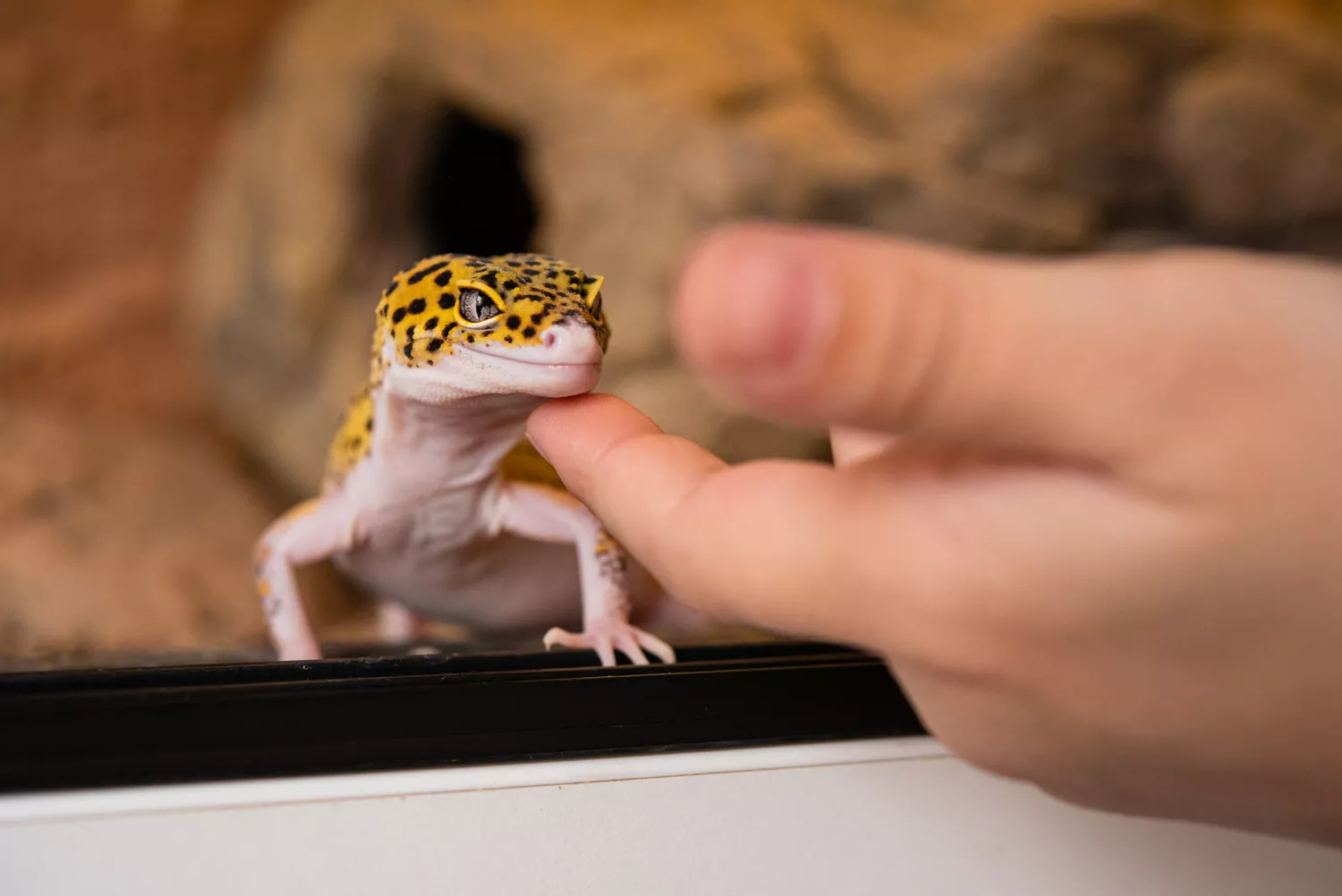f allergies keep your family from having a furry pet in your house, and the idea of a bird or fish doesn’t excite your or your kids, a reptile may be a great option for a pet. Reptiles are quiet, there are many species that don’t take up a lot of space, they don’t make big messes, and kids can interact with and hold them. But not all types of reptiles make ideal pets for kids. Some reptiles are too large for kids to handle or too dangerous for a child to clean or feed. It’s best to find out what kinds of reptiles are easy for kids to handle and care for before you commit to having one live in your home. Here are the six easiest pet reptiles for kids to take care of.
-
01of 06
Leopard Geckos

Leopard geckos are excellent pets for kids.Getty Images/Alexandra Jursova Leopard geckos are very popular with kids and adults for several reasons. They come in a variety of colors, are easy to handle, are not aggressive, have fairly simple habitat requirements, are clean, and can live up to 20 years as pets. Leopard geckos don’t need complex habitats, do not require UVB lighting, and eat small insects. They are fun for children to feed and their enclosures can be spot-cleaned by kids in between full cleanings. Leopard geckos are also terrestrial lizards, so they spend a lot of time in their burrows inside their habitats and are easy to find.
Species Overview
LENGTH: 8 to 10 inches including the tail
WEIGHT: 50-80 grams
PHYSICAL CHARACTERISTICS: Large eyes, traditionally yellow, black, and white but can come in many morphs. Thick tail almost as long as the body, bumpy but soft skin.
-
02of 06
Bearded Dragons
Witblits are gaining in popularity Larger than a leopard gecko, a bearded dragon will require a little more space and lighting but it is just as docile. Bearded dragons are easy to handle and are hardier than leopard geckos, but they also require fresh veggies on a daily basis. This will put your child to work cutting up dark, leafy greens each day. Otherwise, if your habitat is set-up correctly with the proper heat and lighting, they are easy to maintain.
Species Overview
LENGTH: 16-24 inches including the tail
WEIGHT: 300-600 grams
PHYSICAL CHARACTERISTICS: Traditionally sand colored but many different morph colors are available. Spiky, rough skin, triangle-shaped head, long tail.
-
03of 06
Corn Snakes
Corn snakes are docile and lightweight snakes. Nathan Shepard / Getty Images If your child isn’t a lizard fan, then consider a corn snake. This slithering option is docile, easy to handle, comes in a few color options, is quiet, clean, and doesn’t even require much in the way of daily attention, feeding, or even lighting. Corn snakes need secure housing to prevent them from escaping, but similar to a leopard gecko, a heat light is really the only other special thing this reptile needs. Adult corn snakes only need to be fed once a week or so, but you and your child will need to be comfortable feeding your pet pre-killed mice that are stored in the freezer.
Species Overview
LENGTH: 3-5 feet
WEIGHT: 500-900 grams
PHYSICAL CHARACTERISTICS: Traditionally a red-copper color but available in over 40 morphs, slender, round head.
-
04of 06
Blue-Tongued Skink
Blue-tongued skinks are larger than geckos but make excellent pets for kids. Kristian Bell / Getty Images One of the best lizards for kids is the blue-tongued skink. It is just as docile, easy to handle, and low-maintenance as the other lizards on this list. Blue-tongued skinks are not aggressive but because they are larger, if a small child accidentally gets bit, it will hurt. Older children may appreciate the larger size of a blue-tongued skink and will enjoy preparing their fresh fruits, vegetables, and insects each day. Like a bearded dragon, with a larger size comes a larger enclosure, and these skinks also require proper heat and lighting.
Species Overview
LENGTH: Up to 24 inches including the tail
WEIGHT: 280-510 grams
PHYSICAL CHARACTERISTICS: Blue tongue, smooth scales, short legs, long body.
-
05of 06
Ball Pythons
Ball pythons are small constricting snakes that make good pets for older kids. Getty Images/GK Hart/Vikki Hart Another great snake option for kids is the ball python. This snake will also need to be fed pre-killed mice, but if that doesn’t bother you and your child, a ball python is a thicker snake than the corn snake. It may be too heavy for small children to pick up without assistance and ball pythons can live for several decades, so if you don’t want to get stuck caring for this snake once your child leaves home, that’s something to consider. If, however, you’re looking for a long-lived, docile pet reptile, these pythons are a great option.
Species Overview
LENGTH: 4-5 feet
WEIGHT: 1,000-2,000 grams
PHYSICAL CHARACTERISTICS: Thick-bodied, camouflage colors, black, brown-patterned, triangular head.
-
06of 06
Russian Tortoises
Russian tortoises stay under eight inches in length and are very hardy.Getty Images/Douglas Sacha Not every kid is into caring for a slithery reptile, so a tortoise might be more their style. Russian tortoises are extremely docile, slow-moving, quiet, and live a long time. They do require proper heat and lighting as well as fresh veggies on a daily basis, but their size and demeanor are perfect for kids. Plus, they are very hardy so for kids who might still be learning to handle pets gently, Russian tortoises could be a good fit. They come with their own built-in helmets.
Species Overview
LENGTH: 4-8 inches
WEIGHT: 300-1500 grams
PHYSICAL CHARACTERISTICS: Tan, brown and black markings, low to the ground, rounded carapace.
Reptiles to Avoid
Aggressive, large, and venomous reptiles should be avoided as pets for kids. Larger constricting snakes, large tortoises, and lizards that are agile and fast are also not good options as they may hurt a child or a child may accidentally hurt them.